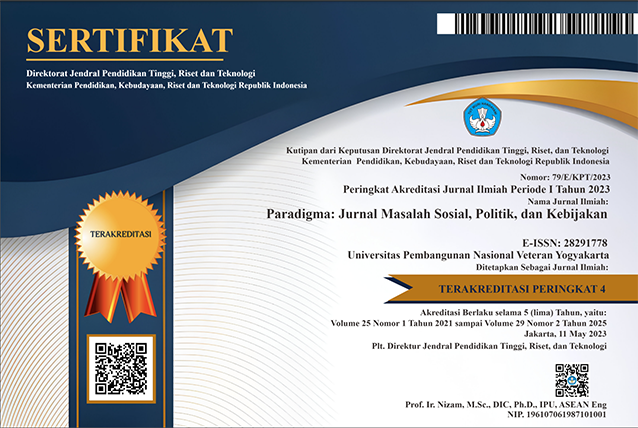Pengaruh Financial Attitude dan Fintech Literacy pada Financial Inclusion (Studi Kasus Pada Mahasiswa UPN Veteran Yogyakarta)
DOI:
https://doi.org/10.31315/paradigma.v28i1.11840Keywords:
Financial Attitude, Fintech Literacy, Financial InclusionAbstract
Abstract
This research aims to investigate the impact of Financial Attitude and Fin-Tech Literacy on financial inclusion among UPN Veteran Yogyakarta students who use Go-Pay services. A total of 200 respondents were selected using a non-probability sampling method. Data analysis was carried out using Smart PLS statistical test tool. The research results show that both Financial Attitude and Fin-Tech Lietracy have a significant and positive influence on student financial inclusion. These findings highlight the positive role of financial attitudes and fintech literacy in encouraging student involvement in financial inclusion, particularly through the use of Go-Pay. This research provides valuable insights for the development of financial inclusion programs in academic environments, emphasizing the importance of understanding and improving financial attitudes an fin-tech literacy in supporting students’ active participation in digital financial services such as Go-Pay.
References
Alba, J. W., & Hutchinson, J. W. (1987). Dimensions of Consumer Expertise. Journal of Consumer Research, 13(4), 411. https://doi.org/10.1086/209080
Amagir, A., Groot, W., Maassen van den Brink, H., & Wilschut, A. (2018). A review of financial-literacy education programs for children and adolescents. Citizenship, Social and Economics Education, 17(1), 56-80. https://doi.org/10.1177/2047173417719555
Amagir, A., Groot, W., van den Brink, H. M., & Wilschut, A. (2020). Financial literacy of high school students in the Netherlands: knowledge, attitudes, self-efficacy, and behavior. International Review of Economics Education, 34, 100185. https://doi.org/10.1016/j.iree.2020.100185
ANNAMARIA LUSARDI, OLIVIA S. MITCHELL, & VILSA CURTO. (2010). Financial literacy among the young. The Journal of Consumer Affairs, 44(2), 358-380.
Badan Pusat Statistik (BPS - Statistics Indonesia). (2023, October 31). Ekonomi Indonesia Tahun 2022. ): Https://Www.Bps.Go.Id/Pressrelease/2023/02/06/1997/Ekonomi-Indonesia-Tahun-2022-Tumbuh-5-31-Persen.Html.
Beyene Fanta, A., & Makina, D. (2019). The Relationship Between Technology and Financial Inclusion. In Extending Financial Inclusion in Africa (pp. 211-230). Elsevier. https://doi.org/10.1016/B978-0-12-814164-9.00010-4
Grohmann, A. (2018). Financial literacy and financial behavior: Evidence from the emerging Asian middle class. Pacific-Basin Finance Journal, 48, 129-143. https://doi.org/10.1016/j.pacfin.2018.01.007
Hair, J. F., Howard, M. C., & Nitzl, C. (2020). Assessing measurement model quality in PLS-SEM using confirmatory composite analysis. Journal of Business Research, 109, 101-110. https://doi.org/10.1016/j.jbusres.2019.11.069
Ilya Avianti, & Triyono. (2021). EKOSISTEM FINTECH DI INDONESIA (M. Akbar, S. Rinaldi, F. Nova, & W. Mumpuni, Eds.; Vol. 1). PT. Kaptain Komunikasi Indonesia.
Johan, I., Rowlingson, K., & Appleyard, L. (2021). The Effect of Personal Finance Education on The Financial Knowledge, Attitudes and Behaviour of University Students in Indonesia. Journal of Family and Economic Issues, 42(2), 351-367. https://doi.org/10.1007/s10834-020-09721-9
Joseph F. Hair JR, William C. Black, Barry J. Babin, & Rolph E. Anderson. (2010). Multivariate Data Analysis (7th ed.). Pearson.
JULIA KAGAN. (2023, December 30). Financial Technology (Fintech): Its Uses and Impact on Our Lives.
Kaiser, T., Lusardi, A., Menkhoff, L., & Urban, C. (2022). Financial education affects financial knowledge and downstream behaviors. Journal of Financial Economics, 145(2), 255-272. https://doi.org/10.1016/j.jfineco.2021.09.022
Kendzia, M. J., & Borrero, Y. S. (2022a). Financial Literacy among the Youth in Switzerland. Journal of Financial Risk Management, 11(02), 323-341. https://doi.org/10.4236/jfrm.2022.112017
Kendzia, M. J., & Borrero, Y. S. (2022b). Financial Literacy among the Youth in Switzerland. Journal of Financial Risk Management, 11(02), 323-341. https://doi.org/10.4236/jfrm.2022.112017
Kitakogelu, P. (2018). Munich Personal RePEc Archive Impact of Digital Finance on Financial Inclusion and Stability.
Lim, T. S., Mail, R., Abd Karim, M. R., Ahmad Baharul Ulum, Z. K., Jaidi, J., & Noordin, R. (2018). A serial mediation model of financial knowledge on the intention to invest: The central role of risk perception and attitude. Journal of Behavioral and Experimental Finance, 20, 74-79. https://doi.org/10.1016/j.jbef.2018.08.001
Liska, R., Wediawati, B., & Machpudin, A. (n.d.). Pengaruh Literasi Keuangan Dan Financial Technology Terhadap Inklusi Keuangan (Studi Kasus Pada Mahasiswa Program Studi S1 Manajemen Kosentrasi Keuangan Fakultas Ekonomi Dan Bisnis Universitas Jambi). Jurnal Dinamika Manajemen, 10(2).
Lusardi, A. (2019). Financial literacy and the need for financial education: evidence and implications. Swiss Journal of Economics and Statistics, 155(1), 1. https://doi.org/10.1186/s41937-019-0027-5
Morgan, P. J., & Long, T. Q. (2020). Financial literacy, financial inclusion, and savings behavior in Laos. Journal of Asian Economics, 68, 101197. https://doi.org/10.1016/j.asieco.2020.101197
Otoritas Jasa Keuangan. (2022, November 24). INFOGRAFIS HASIL SURVEI NASIONAL LITERASI DAN INKLUSI KEUANGAN TAHUN 2022.
Risa Liska, Besse Wediawati, & Asep Machpudin. (2023). Pengaruh Literasi Keuangan Dan Financial Technology Terhadap Inklusi Keuangan (Studi Kasus Pada Mahasiswa Program Studi S1 Manajemen Kosentrasi Keuangan Fakultas Ekonomi Dan Bisnis Universitas Jambi). Jurnal Dinamika Manajemen, 10(2), 86-94.
Seifelyazal, M., Salaheldin, A., & Assem, M. (2023). The Impact of Financial Inclusion on Income Inequality. Open Journal of Social Sciences, 11(06), 255-274. https://doi.org/10.4236/jss.2023.116018
Shaw, M. (2010). Book Review: Freedman, L. (2006). The Transformation of Strategic Affairs. Adelphi Paper No. 379. London: International Institute for Strategic Studies. Armed Forces & Society, 36(2), 380-382. https://doi.org/10.1177/0095327X08320647
Wynne W. Chin. (2009). How to Write Up and Report PLS Analyses. Springer Handbooks of Computational Statistics.
Wynne W. Chin, & G. Marcoulides. (1998). The Partial Least Squares Approach to Structural Equation Modeling (Vol. 8). Lawrence Erlbaum Associates.
Yang, T., & Zhang, X. (2022). FinTech adoption and financial inclusion: Evidence from household consumption in China. Journal of Banking & Finance, 145, 106668. https://doi.org/10.1016/j.jbankfin.2022.106668
Downloads
Published
How to Cite
Issue
Section
License
The manuscript submitted to Paradigma: Jurnal Masalah Sosial, Politik, dan Kebijakan journals are released under the license of Creative Commons Attribution-Non Commercial- ShareAlike (CC BY SA) if and when the article is accepted for publication.
We declare that:
- This paper has not been published in the same form elsewhere.
- It will not be submitted anywhere else for publication prior to acceptance/rejection by this Journal.
- A copyright permission is obtained for materials published elsewhere and which require this permission for reproduction.
Retained Rights/Terms and Conditions
Authors retain all proprietary rights to the published works, such as (but not limited to) the following rights:
- Copyright and other proprietary rights relating to the article, such as patent rights,
- The right to use the substance of the article in own future works, including lectures and books,
- The right to reproduce the article for own purposes,
- The right to self-archive the article
The right to enter into separate, additional contractual arrangements for the non-exclusive distribution of the article's published version (e.g., post it to an institutional repository or publish it in a book), with an acknowledgment of its initial publication in this journal Paradigma: Jurnal Masalah Sosial, Politik, dan Kebijakan



